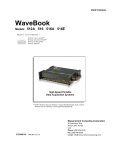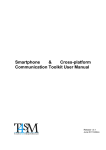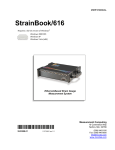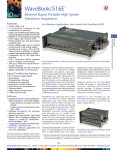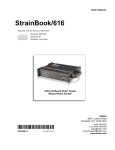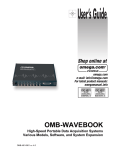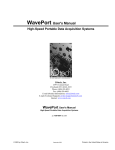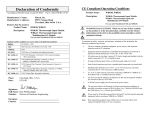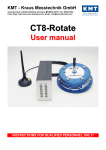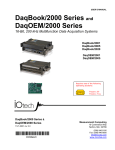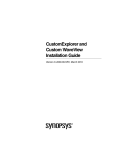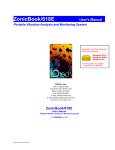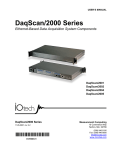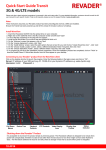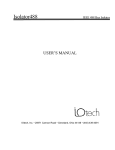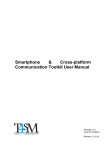Download Ethernet-Based Strain Gage Measurement System
Transcript
EW N ™ StrainBook/616 ® Ethernet-Based Strain Gage Measurement System Features • 8-channels built-in, expandable up to 64 channels per StrainBook • Multiple StrainBooks can be synchronized for applications >64 channels • Expansion options for voltage, temperature, vibration, and sound measurements • High-speed Ethernet interface for continuous measurement transfer to the PC • 1-MHz scanning A/D converter, with simultaneous sample and hold on each channel, guaranteeing channelto-channel phase match to within 100 nsec • 100% programmable, no mechanical pots to adjust • Full, half, and quarter arm support • 60 to 1000 Ohm bridge • Software-selected Shunt-Cal • Independent filter per channel • Programmable excitation source • DC operable for in-vehicle applications Software • Includes WaveView™ for Out-of-the-Box™ setup, acquisition, & real-time display: – Scope mode for real-time waveform display – Logger mode for continuous streaming to disk • Support for Visual Studio® and Visual Studio® .NET, including examples for Visual C++®, Visual C#®, Visual Basic®, and Visual Basic® .NET • Comprehensive drivers for DASYLab®, LabVIEW®, and MATLAB® StrainBook/616™ is a compact and portable strain gage measurement system that connects to your PC’s Ethernet port. Eight channels of strain measurement are built into the StrainBook, and up to 64 channels can be measured with one StrainBook using 8-channel WBK16 ™ options. For applications with more than 64 channels, multiple StrainBook systems can be combined and synchronized for a virtually limitless number of strain measurement channels. The StrainBook is also capable of measuring voltage, temperature, vibration, and sound using other WBK signal conditioning options. The Ethernet-based StrainBook/616 provides from 8 to 64 channels of automated bridge measurements WaveView™ software is included with the StrainBook, providing all set-up, data acquisition, real-time display, and storage to disk without having to program. WaveView supports up to 64 channels of strain, voltage, or sound/vibration inputs. For applications beyond 64 channels, or for custom applications, comprehensive drivers are included for all Windows languages, LabVIEW®, and DASYLab®. Built into the StrainBook is a 16-bit, 1-MHz A/D converter that can scan all selected channels at 1 µsec per channel, and continuously transmit acquired data to the PC in real time. Simultaneous sample and hold amplifiers on every channel insure that all channels are measured within 100ns of each other. The only limit to the amount of data acquired or the duration of a test is the storage capacity on the host PC. If all 8 channels of the StrainBook are configured, then the maximum sample rate per channel would be 125 kHz. If 64 channels of strain are configured, then the maximum rate per channel would be 1M/64 = 15.6 kHz per channel. The StrainBook supports a wide range of bridge values for full-, half-, and quarterbridge configurations. Excitation voltage with remote sensing is supplied from an internal supply, eliminating the need for an external voltage source. The StrainBook’s wide gain ranges and filter selection (see specifications) also make it an excellent general purpose or high gain amplifier for other transducer inputs. All input signals are attached via eight DB9 connectors on the front of the unit. Each of the eight channels has an independent gain stage, software programmable in 86 steps from 1 to 20,000, providing optimal gain for any strain application. The excitation source is accurate to ±5 mV with very low drift over time. The dual excitation sources are set through software for 0.5, 1, 2, 5, and 10 volt excitation, and can be used in either a standard or 6-wire Kelvin configuration. Each source is individually current limited to 85 mA to protect against accidental shorts. Both high-pass AC coupling and low-pass noise rejection filtering can be enabled through software. Two 4-pole Butterworth filters factory-set to corner frequencies of 10 Hz or 1 kHz can be selected. The filters can be user-modified over a range of 2 Hz to 20 kHz simply by inserting a user-supplied resistor pack. Unlike most strain instruments with a single fixed configuration, the WBK16 allows multiple bridge configurations to be established in advance on a user-installed header. 32 www.iotech.com • IOtech, Inc. • 25971 Cannon Rd • Cleveland, OH 44146 • (440) 439-4091 • Fax (440) 439-4093 • [email protected] ™ StrainBook/616 ® General Information Unlike example programs that many suppliers provide with data acquisition hardware, WaveView is a full-featured acquisition and display package designed to quickly configure strain, load cell, pressure, and other sensors for your data-logging and display applications. Three user-provided, software-selectable, shunt-calibration resistors can be installed on each channel, enabling each to be put into a known imbalance condition to set channel calibration. Shunt-Cal allows a full scale gain without physically loading the bridge to capacity. WaveView’s intuitive approach to hardware control simplifies system setup by automatically querying the StrainBook upon connection to your PC. As WBK options are added for signal conditioning or increased system channel count, 2 WaveView’s channel configuration spreadsheet automatically expands to accommodate the additional channels. Specific channel characteristics, such as gain, unipolar/bipolar, and channel labels, are automatically updated, and any additional functionality (such as low-pass filtering, filter cutoff, or excitation output), automatically appear in the channelconfiguration spreadsheet. WaveView is also designed for easy operation with other analysis packages, providing data in formats compatible with a variety of analysis packages including MATLAB®. Balancing the bridge is quick and convenient, since there are no pots to adjust. Simply select the channels to auto-balance and the StrainBook does the rest. Auto-balance removes the static portion of the strain load and auto zeros the input to compensate for any input drift. WaveView™ Out-of-the-Box™ Software WaveView is a Windows®-based setup and acquisition application that allows you to configure, display, and save data to disk within minutes of taking the StrainBook out of the box. WaveView provides a point-and-click interface to simplify StrainBook operations by allowing setup of all hardware, including the field added WBK expansion options, all without programming. Easy Strain Setup Whether you are working with strain gages, pressure transducers, load cells or some other strain based gage, WaveView’s point-andclick configuration makes the setup easy. 1 4 2 3 WaveView supports various sensor types including strain 1 gages, pressure transducers, load cells, and piezoresistive accelerometers. 2 Easily calibrate various strain configurations using one of three user added shunt calibration resistors or the two point manual method. In addition, name plate and two point auto is available for load, pressure, and other transducers. The date is automatically recorded at the time of calibration 3 Type in your units of choice and user labels for quick signal identification. smart cell approach to data entry takes the guess 4 IOtech’s work out what data is needed. Only the cells that require your input are made visible based on your sensor type selection. 33 www.iotech.com • IOtech, Inc. • 25971 Cannon Rd • Cleveland, OH 44146 • (440) 439-4091 • Fax (440) 439-4093 • [email protected] StrainBook Ethernet-Based Strain Gage Measurement Once installed, each configuration can be selected through software at the time of operation. Each header supports two half bridge resistors, three quarter bridge values and three shunt cal values per channel. All configurations can be selected via software on a per-channel basis. ™ StrainBook/616 ® General Information & Specifications Scan and Trigger Configuration Specifications The StrainBook’s powerful event-capture capability is made available through the simple, fill-in-the-blank style dialog boxes in WaveView. In addition to single-channel, manual, and external TTL triggering, advanced triggering for multichannel, digital pattern, and pulse trigger is also available. When using multichannel trigger all channels can be combined with Boolean “AND” & “OR” operators to begin the acquisition at the right time. In digital pattern mode, the StrainBook triggers on a userdefined bit pattern making it easy to associate analog data with digital sequences. Channels: 8 built-in, expandable to 64 Input Connector: Standard female DB9 per channel Input Type: Differential Input Impedance: 100M Ohms Coupling: AC and DC, software selectable Accuracy: Offset Drift: 1µV RTI/˚C CMRR @ DC to 60 Hz: 100 dB at gains > 100 Cross-Talk Rejection: > 90 dB @ less than 1 kHz Bandwidth: 50 kHz @ gains < 1 to 100 10 kHz @ gains > 100 to 2000 1 kHz @ gains > 2000 Bridge Configuration: Full-bridge (4 and 6 wire) Half-bridge Quarter-bridge (2 and 3 wire) Bridge Completion: User supplied resistors on removable headers (headers included) Bridge Resistance: 60 to 1000 Ohms Overall Gain: 1 to 20,000, software selectable in 86 steps Shunt Calibration: software selection of 3 user-supplied resistors Auto-Balance: Selected per channel Auto-Calibration: Either by actual measurement or by calculated load Offset Adjustment: ±3 V RTI @ gains 1 to 10 ±300 mV RTI @ gains 10 to 100 ±30 mV RTI @ gains 100 to 2000 ±3 mV RTI @ gains 2000 to 20000 Excitation Source: Two banks can be independently set to 0.5, 1.0, 2.0, 5.0, 10.0 VDC or “off” Bank 1 is for Channels 1 through 4; Bank 2 is for Channels 5 through 8. Excitation Accuracy: ±5 mV Excitation Capacity: 85 mA per channel with fold-back current limiting Filtering: 4-pole Butterworth, software-selectable and factory-set to 10 Hz, 1 kHz, or bypass; field-changeable Warm-up: 30 minutes to rated specifications Environment: Operating: 0˚ to 50˚C, 0 to 95% RH, non-condensing Storage Temperature: -20˚ to 70˚C Power Consumption: 1.22A @ 15V (min); 1.84A @ 15V (max) Input Power Voltage Range: 10 to 30 VDC Vibration: MIL STD 810, Category 1 and 10 PC Communication: 10/100BaseT Ethernet Dimensions: 285 mm W x 220 mm D x 70 mm H (11” x 8.5” x 2.70”) Weight: 1.32 kg (2.9 lb) Scope Mode Unlike a traditional scope with only two to four channels, WaveView’s Scope Mode allows any eight channels within a system to be displayed. WaveView is not handicapped by the small memory limitations of DSOs, and dynamically and transparently allocates a PC’s RAM prior to beginning an acquisition. A simple point-and-click is all that’s necessary to initiate acquisitions. Because the data is already in the PC’s RAM, a second point-and-click on the disk icon automatically saves data to disk for import into eZ-PostView™, a post-acquisition waveform review package included with WaveView, or into analysis packages, such as MATLAB®, DADiSP™, or Excel®. Logger Mode For applications where PC RAM is insufficient to record the entire test or where rapid back-to-back recordings need to be saved to disk, WaveView provides a Logger Mode. It complements WaveView’s Scope Mode by allowing continuous data recording directly to disk. Logger Mode can auto-increment file names to provide the unattended capture of millions of back-toback events, without user intervention. Acquired data can be stored in several data formats for direct import to packages such as MATLAB®, Excel®, or eZ-PostView™. LabVIEW® Support Triggering Extensive LabVIEW® support is provided for the StrainBook, including expansion and signal conditioning modules. IOtech data acquisition VIs for LabVIEW are more than just simple hardware access VIs; they are complete with engineering data conversion, data display, and logging capabilities. DASYLab® If your application requirements go beyond the scope of WaveView™, DASYLab® software offers a great degree of flexibility and customization. You can learn DASYLab in a matter of days, without the weeks of training required for some other icon-based application-development software. Multi-Channel Analog Trigger (up to 64 channels) Range: Selectable per channel to input range Latency: 2 µs/channel, plus 4 µs maximum TTL Trigger Input Signal Range: 0 to 5V Input Characteristics: TTL-compatible with 10K Ohm pull-up resistor Latency: 300 ns Software Trigger Latency: 100 µs typical External Clock Connector: Available on DB25 digital input Input Signal Range: 5V TTL compatible Input Characteristics: 50K Ohms pull up (to +5V) in parallel with 50 pF Input Protection: Zener clamped -0.7 to +5V Delay: 200 ns Signal Slew Rate Requirement: 20V/µs minimum Rate: Up to 1 MHz Divisor Ratio: Divide by 1 through 255, selectable Clock Counter Accuracy: <0.02% Clock Counter Range: 0.01 Hz to 100 kHz 34 www.iotech.com • IOtech, Inc. • 25971 Cannon Rd • Cleveland, OH 44146 • (440) 439-4091 • Fax (440) 439-4093 • [email protected] ™ StrainBook/616 ® Specifications & Ordering Information External Sync Ports Number of External Sync Ports: 2, on rear panel Maximum Number of Units to be Synchronized: 4 units, scan synchronous (post trigger) Maximum Length of Sync Cables: 15 feet (4.57 m), total for all cables Sequencer Operation: Programmable for channel, gain, and for unipolar/bipolar range in random order Depth: 128 location Channel-to-Channel Rate: 1 µs to 1.1 µs/channel, all channels equal Maximum Repeat Rate: 1 MHz Minimum Repeat Rate: 100 seconds per scan Expansion Channel Sample Rate: Same as on-board channels, 1 to 1.1 µs, fixed The WBK10A adds eight differential analog inputs 2 Connector: DB25 Female Configuration: 16 TTL-compatible pins, selectable for input or output Input Characteristics: TTL-compatible Output Characteristics: ALS TTL output in series with 33 Ohms Output Updates: Outputs may be changed via program control Input/Output Protection: Diode clamped to ground and +5V The WBK15 provides up to 8 isolated analog input channels Period Counter Operation: Internal counter calculates and reports the external clock’s period; counter can be read with each scan Clock Counter Accuracy: <0.02% error Clock Counter Range: 0.01 Hz to 100 kHz Ordering Information Description 8 channel Ethernet-based strain gage measurement system, including WaveView™ software; support for Visual Studio ® and Visual Studio® .NET; and comprehensive drivers for DASYLab®, LabVIEW®, and MATLAB® Part No. StrainBook/616 The WBK16 provides eight channels of strain gage input Expansion Options 8-channel voltage expansion option for the StrainBook WBK10A Simultaneous sample and hold option for the WBK10A WBK11A Programmable filter option for the WBK10A WBK12A Simultaneous sample and hold plus filter option for the WBK10A WBK13A 8-channel isolated multifunction option for the StrainBook (5B signal conditioning options sold separately) WBK15 8-channel strain gage expansion option for the StrainBook with simultaneous sample and hold WBK16/SSH 8-channel strain gage expansion option for the StrainBook (without simultaneous sample and hold) WBK16 8-channel counter/position encoder option for the StrainBook WBK17 8-channel ICP accelerometer/microphone option for the StrainBook WBK18 14-channel TC option for the StrainBook (Note: not supported in WaveView software – requires DASYLab or a user-developed application with LabVIEW or Windows language) WBK40 14-channel TC option, plus 4 counter inputs, for the StrainBook (Note: not supported in WaveView software – requires DASYLab or a user-developed application with LabVIEW or Windows language) WBK41 The WBK18 provides a full set of features for making dynamic signal measurements Accessories Description Header connector* Shunt and completion resistor header* Connector/adapter DB9 to screw terminal Part No. CN-115 CN-115-1 CN-189 The WBK41 provides thermocouple and counter inputs (not supported in WaveView) Software Icon-based data acquisition, graphics, control, and analysis software with StrainBook driver DASYLab * The CN-115 header is used for axial leaded bridge completion resistors. The CN-115-1 can be used with both axial leaded and upright (square) precision resistors. See user’s manual for assembly instructions. 35 www.iotech.com • IOtech, Inc. • 25971 Cannon Rd • Cleveland, OH 44146 • (440) 439-4091 • Fax (440) 439-4093 • [email protected] StrainBook Ethernet-Based Strain Gage Measurement High-Speed Digital Inputs/General-Purpose Outputs




